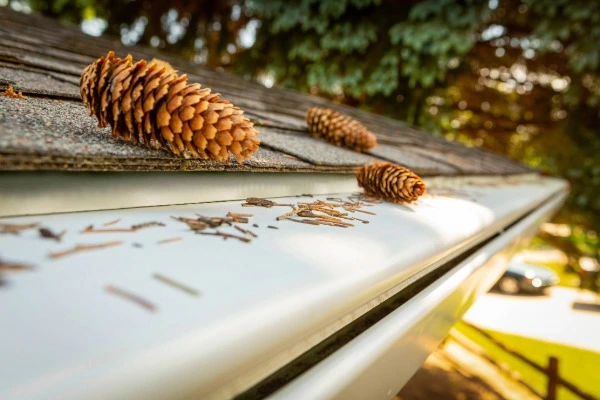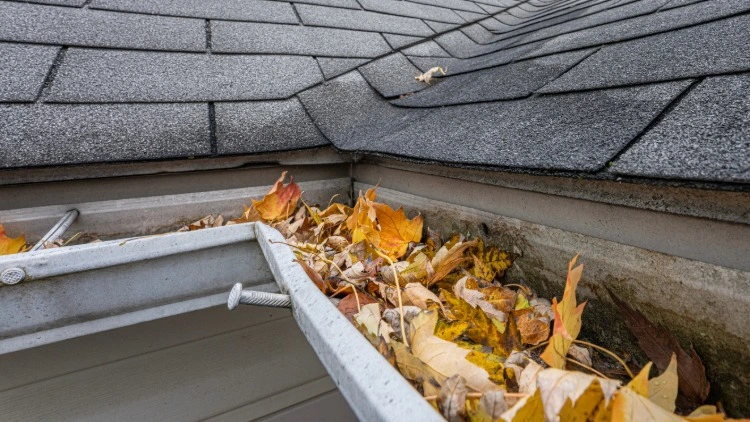Your towering oaks, sprawling maples, and majestic spruces and pines create a picture-perfect landscape, but they’re also waging a quiet war against your home’s exterior. Every season brings a fresh assault of leaves, twigs, and debris that can transform your gutters into clogged waterways and turn your roof into a maintenance nightmare. Living on heavily treed properties means dealing with unique challenges that standard gutter systems weren’t designed to handle.
When fall arrives, your gutters fill faster than you can clean them. Pine needles slip through mesh screens like tiny green needles threading through fabric, maple seeds take root in downspouts, and winter storms dump branches that can damage both gutters and roofing materials.
That’s why protecting your home with the best gutter guards for leaves, along with proactive roof care, becomes essential for anyone living under nature’s canopy.
Why Standard Gutters Can’t Handle the Tree Challenge
Here’s what happens when trees and traditional gutters go head-to-head: the trees always win. Leaves, pine needles, and twigs don’t just fall gracefully onto your lawn. They find their way onto your roof and directly into your gutters.
The Leaf Problem Gets Worse Every Year
Traditional open gutters become debris magnets where oak leaves pile up like autumn snowdrifts. What starts as a few scattered leaves quickly turns into miniature forests where maple seeds sprout. Before you know it, you’re looking at a gutter system that’s completely overwhelmed.
Pine Needles: Silent Gutter Killers
Pine needles are especially problematic. Their thin profile allows them to slip through most mesh guards. They accumulate and form dense mats that block water flow entirely.
The Endless Maintenance Cycle
The constant cycle of clogging and cleaning forces homeowners up and down ladders multiple times per year, risking injury while fighting what feels like an endless battle. When water can’t flow freely, you’ll see overflowing gutters, sagging gutters, ice dams in colder months, and even foundation damage.
Finding the Best Gutter Guards for Leaves
When you’re shopping for the best gutter guards for leaves, effectiveness matters more than price, every single time. We’ve seen too many homeowners learn this lesson the hard way.
Why Mesh Guards Fall Short
Standard mesh screens might seem like an affordable solution, but they often create more problems than they solve. Leaves and needles pile on top, building dams that force water to spill over the sides. As the debris decomposes, seeds germinate. You end up with a rooftop garden that nobody wants.
What Actually Works
The most effective leaf protection systems use curved hoods that allow leaves to slide off while directing water into the gutter channel. This design harnesses gravity and wind to naturally clear debris rather than trying to filter it, and it actually works in real-world conditions.
Solving the Pine Needle Puzzle
Many homeowners ask us: “Are there gutter guards for pine needles that work?” The answer is yes, but you need to know what to look for.
Why Spruce and Pine Needles Are Different
Spruce and pine needles deserve special attention because they’re uniquely problematic. Unlike larger leaves that might sit on top of mesh guards, spruce and pine needles slip into or through the mesh panel. Long line needles stand vertically, while spruce needles build up like miniature logs in the bottom of gutters. As they build up, they create clogs in the gutter system. The best gutter guards for spruce and pine needles feature solid surfaces with carefully engineered openings that prevent needle infiltration while maintaining optimal water collection.

The Curved Hood Advantage
The curved hood design excels in pine-heavy environments because needles simply slide off the surface rather than getting trapped or slipping through. It’s elegant in its simplicity and effective in practice.
Trees and Downspout Requirements: What You Need to Know
If you’ve ever watched water cascade off your roof during a heavy storm, you’ve witnessed another challenge trees create for standard gutter systems. Trees concentrate rainwater into torrents that can overwhelm your gutter system.
When rain hits your large tree canopies, it sheets off in concentrated streams, creating intense water flow during storms. Properties with extensive tree coverage need downspout placement every 20-30 feet instead of the standard 30-40 feet to handle this concentrated runoff effectively.
Watch for these warning signals that your heavily treed property needs additional downspouts:
- Gutters spilling over during heavy rain
- Water pooling near the foundation
- Visible erosion in landscaping
- Overflow near entryways or patios
- Staining on the siding below the gutters
Don’t forget about size, either. Oversized downspouts (3×4 inches) are crucial because standard downspouts (2×3 inches) simply can’t handle the volume that trees generate during storms. It’s the difference between trying to drain a bathtub through a straw versus a garden hose.
Your Roof Needs Protection Too
Most homeowners don’t realize that their roof takes a beating from those beautiful trees overhead. Between falling branches during storms, leaves that pile up in valleys, and trapped moisture against shingles, heavily treed properties face unique roofing challenges that require proactive maintenance, or you could be looking at repair bills in the tens of thousands.
Preventing Physical Damage
Branches scraping against shingles during windy weather gradually wear away protective granules, creating weak spots where leaks can develop. It happens slowly, but the damage adds up over time.
Managing Moisture and Debris
Leaves that settle in roof valleys trap moisture against shingles, accelerating deterioration and creating perfect conditions for mold growth. The solution starts with strategic tree trimming. Keep branches at least six feet from your roofline to minimize debris accumulation and prevent physical damage during storms.
Professional Inspections Save Money
Regular professional inspections become critical when trees overhang your home. Trained roofers can identify potential problems before they become expensive emergencies.
Why K-Guard Works When Others Don’t
After seeing countless homeowners frustrated with gutter guards that can’t handle real tree coverage, we engineered K-Guard differently.

The Complete System Approach
Unlike mesh guards or inserts that homeowners install, K-Guard is a complete system built to last decades. The patented curved hood design naturally sheds leaves and pine needles while the oversized 6-inch gutters handle the intense water flow that tree canopies create during storms.
Built for Heavy Debris
The system’s 3×4-inch downspouts move water away quickly, preventing backups that cause overflow damage. High-strength polymer hangers spaced every 24 inches provide the structural support to handle heavy loads without sagging or pulling away from fascia boards.
Lifetime Protection for Your Investment
Trees add property value and create curb appeal, but they shouldn’t compromise your home’s integrity. The lifetime clog-free warranty backs our promise with protection. We’ve seen what works and what doesn’t, and we stand behind our system completely.
Professional-grade gutter protection combined with proactive roof maintenance keeps your heavily treed property stunning while preventing costly water damage. Contact K-Guard Heartland today to discover how our engineered systems protect heavily treed properties year-round.




